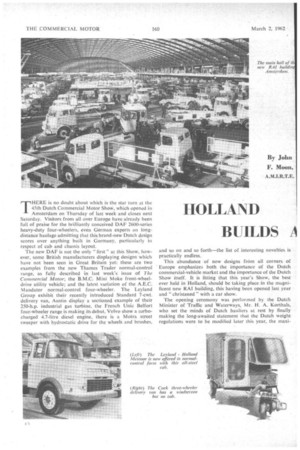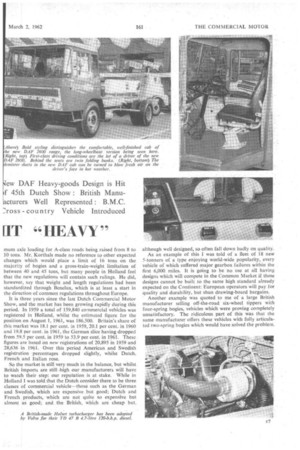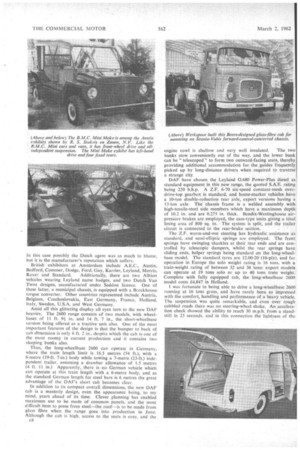HOLLAND BUILDS A
Page 72

Page 73

Page 74

Page 75

Page 76

If you've noticed an error in this article please click here to report it so we can fix it.
FIT "IIEAVY" ew DAF Heavy-goods Design is Hit f 45th Dutch Show : British Manuacturers Well Represented : B.M.C. -2ross country Vehicle Introduced
By John F. Moon,
THERE is no doubt about which is the star turn at the 45th Dutch Commercial Motor Show, which opened in Amsterdam on Thursday of last week and closes next Saturday. Visitors from all over Europe have already been full of praise for the brilliantly conceived DAF 2600-series heavy-duty four-wheelers, even German experts on longdistance haulage admitting that this brand-new Dutch design scores over anything built in Germany, particularly in respect of cab and chassis layout.
The new OAF is not the only " first " at this Show, however, some British manufacturers displaying designs which have not been seen in Great Britain yet: these are two examples from the new Thames Trader normal-control range, as fully described in last week's issue of The Commercial Motor; the B.M.C. Mini Moke front-wheeldrive utility vehicle; and the latest variation of the A.E.C. Mandator normal-control four-wheeler. The Leyland Group exhibit their recently introduced Standard 7-cwt. delivery van, Austin display a sectioned example of their 250-h.p. industrial gas turbine, the French Unic Belfort four-wheeler range is making its debut, Volvo show a turbocharged 4.7-litre diesel engine, there is a Motra street sweeper with hydrostatic drive for the wheels and brushes,
and so on and so forth—the list of interesting novelties is practically endless.
This abundance of new designs from all corners of Europe emphasizes both the importance of the Dutch commercial-vehicle market and the importance of the Dutch Show itself. It is fitting that this year's Show, the best ever held in Holland, should be taking place in the magnificent new RAT building, this having been opened last year and "christened" with a car show.
The opening ceremony was performed by the Dutch Minister of Traffic and Waterways, Mr. a A. Korthals, who set the minds of Dutch hauliers at rest by finally making the long-awaited statement that the Dutch weight regulations were to be modified later this year, the maxi mum axle loading for A-class roads being raised from 8 to 10 tons. Mr. Korthals made no reference to other expected changes which would place a limit of 16 tons on the majority of bogies and a gross-train-weight limitation of between 40 and 45 tons, but many people in Holland feel that the new regulations will contain such rulings. He did, however, say that weight and length regulations had been standardized through Benelux, which is at least a start in the direction of common regulations throughout Europe.
It is three years since the last Dutch Commercial Motor Show, and the market has been growing rapidly during this period. In 1959 a total of 159,840 commercial vehicles was registered in Holland, whilst the estimated figure for the position on August 1, 1961, was 186.500. Britain's share of this market was 18.1 per cent. in 1959, 20.1 per cent. in 1960 and 19.8 per cent. in 1961, the German slice having dropped from 59.5 per cent. in 1959 to 53.9 per cent. in 1961. These figures are bawd on new registrations of 20,895 in 1959 and 28,636 in 1961. Over this period American and Swedish registration percentages dropped slightly, whilst Dutch, French and Italian rose.
So the market is still very much in the balance, but whilst British imports are still ,high our manufacturers will have to watch their step: our reputation is at stake. While in Holland I was told that the Dutch consider there to be three classes of commercial vehicle—those such as the German and Swedish, which are expensive but good; Dutch and French products, which are not quite so expensive but almost as good; and the British, which are cheap but, although well designed, so often fall down badly on quality.
As an example of this I was told of a fleet of 18 new 5-tonners of a type enjoying world-wide popularity, every vehicle of which suffered major gearbox failures within the first 6,000 mites. It is going to be no use at all having designs which will compete in the Common Market if these designs cannot be built to the same high standard already expected on the Continent: European operators will pay for quality and durability, but shun drawing-board bargains.
Another example was quoted to me of a large British manufacturer selling off-the-road six-wheel tippers with four-spring bogies, vehicles which were proving completely unsatisfactory. The ridiculous part of this was that the same manufacturer offers these vehicles with fully articulated two-spring bogies which would have solved the problem.
In this case possibly the Dutch agent was as much to blame, but it is the manufacturer's reputation which suffers.
British exhibitors at Amsterdam include A.E.C.. Austin, Bedford, Commer, Dodge, Ford, Guy, Karrier, Leyland, Morris, Rover and Standard. Additionally, there are two Albion vehicles wearing Leyland name badges, and two Dutch Van Twist designs, manufactured under Seddon licence. One of these latter, a municipal chassis, is equipped with a Brockhouse torque converter. Other countries represented include Austria, Belgium, Czechoslovakia, East Germany, France, Holland, Italy, Sweden, U.S.A. and West Germany.
Amid all this glittering display all eyes turn to the new DAF heavies. The 2600 range consists of two models, with wheelbases of 11 ft. 94 in. and 14 ft. 7 in., the short-wheelbase version being offered as a tractive unit also. One of the most important features of the design is that the bumper to back of cab dimension is only 6 ft. 2 in., despite which the cab is one of the most roomy in current production and it contains two sleeping bunks also.
Thus, the long-wheelbase 2600 can operate in Germany, where the train length limit is 16,5 metres (54 ft.), with a 6-metre (19-ft. 7-in.) body while towing a 7-metre (23-ft.) independent trailer. assuming a drawbar allowance of 1.5 metres (4 ft. 11 in.) Apparently, there is no German vehicle which can operate at this train length with a 6-metre body, and as the standard German length for steel bars is 6 metres the great advantage of the DAF's short cab becomes clear.
In addition to its compact overall dimensions, the new DAF cab is a masterly design, even the appearance being, to my mind, years ahead of its time. Clever planning has enabled maximum use to be made of common panels, and the most difficult item to press from steel—the roof—is to be made from glass fibre when the range goes into production in June. Although the cab is high, access to the seats is easy. and the E8 engine cowl is shallow and very well insulated. The two bunks stow conveniently out of the way, and the lower bunk can be " telescoped " to form two outward-facing seats, thereby providing additional accommodation for the guides frequently picked up by long-distance drivers when required to traverse a strange city. DAF have chosen the Leyland 0.680 Power-Plus diesel as standard equipment in this new range, the quoted S.A.E. rating being 220 b.h.p. A Z.F. 6-70 six-speed constant-mesh overdrive-top gearbox is standard, and home-market vehicles have a 10-ton double-reduction rear axle, export versions having a 13-ton axle. The 'chassis frame is a welded assembly with high-tensile-steel side members which have a maximum depth of 10.2 in. and are 0.275 in. thick. Bendix-Westinghouse airpressure brakes are employed, the cam-type units giving a total lining area of 800 sq. in. The system is split, and the trailer circuit is connected to the rear-brake section.
The Z.F. worm-and-nut steering has hydraulic assistance as standard, and semi-elliptic springs are employed. The front springs have swinging shackles at their rear ends and are controlled by telescopic dampers, whilst the rear springs have sliding ends, helper springs being standard on the long-wheelbase model. The standard tyres are 12.00-20 (16-ply), and for operation in Europe the solo weight rating is 16 tons, with a train-weight rating of between 32 and 36 tons: export models can operate at 19 tons solo or up to 40 tons train weight. Complete with fully equipped cab, the long-wheelbase 2600 model costs £4,847 in Holland.
I was fortunate in being able to drive a long-wheelbase 2600 running at 16 tons gross, and have rarely been so impressed with the comfort, handling and performance of a heavy vehicle. The suspension was quite remarkable, and even over rough cobbled roads there was no steering-wheel shake. An acceleration check showed the ability to reach 30 m.p.h. from a standstill in 23 seconds, and in this connection the lightness of the
unassisted Fichtel and Sachs clutch was remarkable, this Leyland engine haying a British power assistedclutch when used in Leyland vehicles: The range of vision was .outstanding, and very little engine noise penetrated the cab.
I do not find it .hard to see therefore, why this will prove to be a " hit " long-distance haulage vehicle. Much of the success of the cab lies in the fact that several of the DAF designers and development engineers spent their holidays last year riding between Holland and Italy on regular trunk runs: this new cab is the result of their experiences on these journeys. Perhaps some British manufacturers might like to addpt this method of finding out what is really needed?
DAF have, of course, established a valuable bridgehead in Germany, the most popular vehicle there being the 2000-series range, which can operate at 3/ tons gross train weight and has a DAF-modified Leyland 0480 engine of the original type giving 190 b.h.p. (S.A.E.). Several hundreds of these vehicles have been sold in Germany, and they can be seen on the autobahnen cruising steadily at well over 60 m.p.h. Nowa days the DAF range extends downwards to the 5-cwt. pick-up based on the DAF 750 car, an ideal vehicle for both delivery operation and long-distance runs because of its unique Va.riomatic automatic bell-drive transmission, as I can vouch, having covered over 1,000 miles in the course of four days in a vehicle with this system. A relatively minor change to the DAF programme has been the adoption of a British-made Holset turbocharger for their DS 575 5.76-litre diesel engine. The use of this blower has enabled an exhaust brake to be fitted also, the special shaft seals having proved able to stand up to the increased back pressure in the blower housing created when the brake is applied.
Ho!set blowers can be seen on two other European engines at the Show. One of these is on the Scania-Vabis
10.26-litre engine, whilst the other is on the new Volvo TD 47 B 4.7-litre engine, probably the smallest production engine to be turbocharged so far. The blower raises the gross power output frorn-95 to 120 b.h.p., whilst the torque is increased from 200 to 255 lb.-ft. The use of this British equipment by Volvo is encouraging, as hitherto this Swedish company has used only German Eberspacher blowers.
Neither Scania-Vabis nor Volvo manufacture forward control goods chassis as yet, although both concernscan he expected to do so shortly (the Volvo petrol-engined 5-tonner is the exception). Forward-control is popular in Holland, however, so the Dutch agents for both these companies effect forward-control conversions. Beers' Zoncn, N.V., have recently designed a glass-fibre cab for their Scania-Vabis conversions, this being manufactured by Werkspoor. This is the first allplastics cab to be built in Holland and mounts on the standard Beers' sub-frame. The cab weighs 3.5 cwt. less than the usual all-steel cab, and the only ferrous structural members in it are two short lengths of angle iron in the hinge pillars.
The non-standard Volvo models sold in Holland by Nebim include the 61515/90 city-bus model, which has a forwardmounted D47 95-b.h.p. diesel engine and separately mounted Z.F. two-speed automatic gearbox with torque converter. There is no Swedish equivalent of this model, although many standard Volvo components are used in it.
The main British news so far as this Show is concerned, in addition to the Thames, Leyland and Standard models already described in earlier issues, is the B.M.C. Mini Make, details of which have apparently been circulating on the Continent for some weeks although the British Press was kept in the dark. The Mini 'Woke is a front-wheel-drive utility four-seater, based on B.M.C. Mini car components and at present being made available only to Government departments.
There is no payload space, and the all-steel integral body is braced by two deep box-section side members above floor level which form tool boxes and house the petrol tank on the .left side and the battery on the right side. As with the cars, the engine, which is fully water-proofed, is mounted across the front of the vehicle, and all the wheels are independently sprung, the suspension medium being rubber. The Mini Moke has a claimed maximum speed of 70 m.p.h. and its wading depth is 13 in. Dunlop 5.20-10 Weatbermaster tyres are employed, and the Show exhibit is a left-hand-drive version.
In addition to the British vehicles shown on the stands of F 10
their own agents, British products can be seen on several other stands. For example, the success of York third-axle conversions is much in evidence at the Show, several German vehicles being so equipped in addition to some English, an Austrian and an American. Dominating the stand on which York products are concentrated is a Freightmaster 37-ft.-long and 8-ft. 2-in.-wide van semi-trailer, with Thermo King RL 20 refrigerating equipment. This outfit will be used for long distance food haulage at a body temperature of —25°C. by Fransen Transport with a Volvo Titan tractive unit.
This van has an Edbro tailboard hoist and many Edbro bodies, as supplied in Holland by Edbro Europa, N.V., can• be seen around the Show, including one impressive 11-eu.-yd. dump body based on an American Mack 6 x 6 chassis.
British passenger chassis continue to be popular in Holland, there being four Guy Victory exhibits, two with air suspension, and several buses and coaches based on A.E.C. and Leyland running units. Two of the most impressive of these are the Verheul Polyrama coach based on an A.E.C. Reliance chassis, and the Roset Bella Vista 37-seat -coach on Leyland Royal-Tiger Cub chassis, built for Mey's Touring Cars, Arniterdarn; and• equipped with additional higgage capacity (for American tourists), tape recorder and Electrolux 2-cu.-ft. refrigerator, In addition to their Polyrama coach, Verheul show a VB 20 air sprung city bus. this 'having Continental rolling lobe air springs. Verheul, of course, now handle Thornycroft products in Holland as a result of A.E.C.'s take-over last year.
Although most of the ,exhibits on the Verheul stand are passenger vehicles, two examples of their goods-vehicle range are displayed, alongside several A:E.C. freight-haulage designs. Both the Verheul goods chassis have Krornhout diesel engines (Kromhout are not represented elsewhere this year) and both are normal-control designs with appearances not dissimilar to that of-the new A.E.C. Mandator normal-control machine.
Leyland-Holland and Brossel show Leyland-based passenger vehicles and chassis, including a standard Atlantean rear-engined double-deeker chassis which is displayed as a "taster," Leyland being prepared to make a version with a longer wheelbase if there is a demand for this type. Another Leyland-Holland innovation is the Meteoor normal-control vehicle, which has an all-steel cab built by Halcarros, N.V., Halsteren. This has a two-man passenger seat. Turning to delivery vehicles there is much of interest in this field also. There is, for example, a Skoda Octavia 10-cwt. delivery van with lift-up rear dook and a side-loading door behind the line of the car-type cab, this cab being separated from the main body by a steel partition containing a small window. An example of English engine penetration into the Continental market can be seen in the German Ford 15-cwt. van equipped with British Perkins 4.99 diesel engine and exhibited by Van Twist, the Dutch Perkins agents, There are two interesting Dutch light commercial vehicles. One of these is shown by Gazelle Rijwielfabriek. N.V., and is a 1-1.5-tonner with Sachs single-cylinder 9.5-b.h.p. air-cooled petrol engine driving the left-hand rear wheel only through an enclosed chain and a motorcycle-type gearbox. This company also manufactures battery-electric models, these being available with glass-fibre cabs.
Equally unconventional is the Cock three-wheeled delivery van, which has a ILO single-cylinder 2.1-b.h.p. two-stroke petrol engine mounted on the front wheel. This vehicle has a payload capacity of 1 ton, and is tiller steered. Below the waist the driver is unprotected, but there is a sloping glass windscreen (without wiper) protecting his upper body.
Municipal vehicles have for long been a Dutch speciality,, and this year's RAI Show has plenty to offer in this field. There are numerous fire appliances, including Bedfordand Cornmer-based models, and hydraulically operated elevating platforms are much in evidence also. So far as cleansing vehicles are concerned, one of the most interesting exhibits is the Motra three-wheeled street sweeper, which has a VW 16-b.h.p. industrial engine -driving the road wheels and the brushes through hydrostatid transmissions. The Geesink exhibits are, as usual, particularly comprehensive in scope, the range of this 'concern extending from man-powered tricycle dustbin collectors, to fire engines, by way of power-loaded refuse collectors and side-tipping street sweepers.




















































































































































